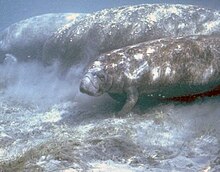Subclass: Theria
Order: Sirenia (manatees and dugongs)

Sirenia is an order of fully aquatic, herbivorous mammals that inhabit rivers, estuaries, coastal marine waters, swamps, and marine wetlands. All four species are endangered.
- Family: Trichechidae
- Genus: Trichechus
- West Indian manatee, T. manatusVU extirpated
- Genus: Trichechus
Order: Chiroptera (bats)
Bats comprised 20% of all mammals described in the world and they are the only true-fliers among mammali. Saint Martin is home for seven bat species.
- Family: Noctilionidae
- Genus: Noctilio
- Greater bulldog bat, Noctilio leporinus ssp. mastivus LR/lc
- Genus: Noctilio
- Family: Phyllostomidae
- Subfamily: Glossophaginae
- Genus: Monophyllus
- Antillean fruit-eating bat, Brachyphylla cavernarum LC
- Genus: Monophyllus
- Insular single leaf bat, Monophyllus plethodon ssp. luciae LR/nt
- Genus: Monophyllus
- Subfamily: Stenodermatinae
- Genus: Ardops
- Tree bat, Ardops nichollsi LR/nt
- Genus: Artibeus
- Jamaican fruit bat, Artibeus jamaicensis LR/lc
- Genus: Ardops
- Subfamily: Glossophaginae
- Family: Natalidae
- Genus: Natalus
- Mexican funnel-eared bat, Natalus stramineus ssp. stramineus LR/lc
- Genus: Natalus
- Family: Molossidae
- Genus: Tadarida
- Mexican free-tailed bat, Tadarida brasiliensis ssp. antillularum LR/nt
- Genus: Molossus
- Velvety free-tailed bat, Molossus molossus ssp. molossus LR/lc
- Genus: Tadarida
- Family: Noctilionidae
Order: Cetacea (whales)
The order Cetacea which includes whales, dolphins and porpoises, are the mammals most fully adapted to aquatic life which enable them to survive like fish in the water. They are armored with thick blubber, limbs evolved as fins and also with tail fin.
- Suborder: Mysticeti
- Family: Balaenopteridae (baleen whales)
- Genus: Balaenoptera
- Common minke whale, Balaenoptera acutorostrata
- Sei whale, Balaenoptera borealis
- Bryde's whale, Balaenoptera brydei
- Blue whale, Balaenoptera musculus
- Genus: Megaptera
- Humpback whale, Megaptera novaeangliae
- Genus: Balaenoptera
- Family: Balaenopteridae (baleen whales)
- Suborder: Odontoceti
- Superfamily: Platanistoidea
- Family: Delphinidae (marine dolphins)
- Genus: Delphinus
- Short-beaked common dolphin, Delphinus delphis DD
- Genus: Feresa
- Pygmy killer whale, Feresa attenuata DD
- Genus: Globicephala
- Short-finned pilot whale, Globicephala macrorhyncus DD
- Genus: Lagenodelphis
- Fraser's dolphin, Lagenodelphis hosei DD
- Genus: Grampus
- Risso's dolphin, Grampus griseus DD
- Genus: Orcinus
- Killer whale, Orcinus orca DD
- Genus: Peponocephala
- Melon-headed whale, Peponocephala electra DD
- Genus: Pseudorca
- False killer whale, Pseudorca crassidens DD
- Genus: Stenella
- Pantropical spotted dolphin, Stenella attenuata DD
- Clymene dolphin, Stenella clymene DD
- Striped dolphin, Stenella coeruleoalba DD
- Atlantic spotted dolphin, Stenella frontalis DD
- Spinner dolphin, Stenella longirostris DD
- Genus: Steno
- Rough-toothed dolphin, Steno bredanensis DD
- Genus: Tursiops
- Common bottlenose dolphin, Tursiops truncatus
- Genus: Delphinus
- Family: Physeteridae (sperm whales)
- Genus: Physeter
- Sperm whale, Physeter catodon DD
- Genus: Physeter
- Family: Kogiidae (dwarf sperm whales)
- Genus: Kogia
- Pygmy sperm whale, Kogia breviceps DD
- Dwarf sperm whale, Kogia sima DD
- Genus: Kogia
- Family: Delphinidae (marine dolphins)
- Superfamily Ziphioidea
- Family: Ziphidae (beaked whales)
- Genus: Mesoplodon
- Gervais' beaked whale, Mesoplodon europaeus DD)
- Genus: Ziphius
- Cuvier's beaked whale, Ziphius cavirostris DD
- Genus: Mesoplodon
- Family: Ziphidae (beaked whales)
- Superfamily: Platanistoidea
Order: Carnivora (carnivorans)
Well over 250 species of carnivorans, they fill up the top ranks of any food web, and helps to control the population of herbivores.
- Suborder: Pinnipedia
- Family: Phocidae (earless seals)
- Genus: Neomonachus
- Caribbean monk seal, Neomonachus tropicalis EX
- Genus: Neomonachus
- Family: Phocidae (earless seals)
Order: Rodentia (rodents)
Rodents are the most successful mammals in the world, comprising more than 40% of all described mammal species. They are economically important animals, where most of them are pests and invasive species in human habitations.